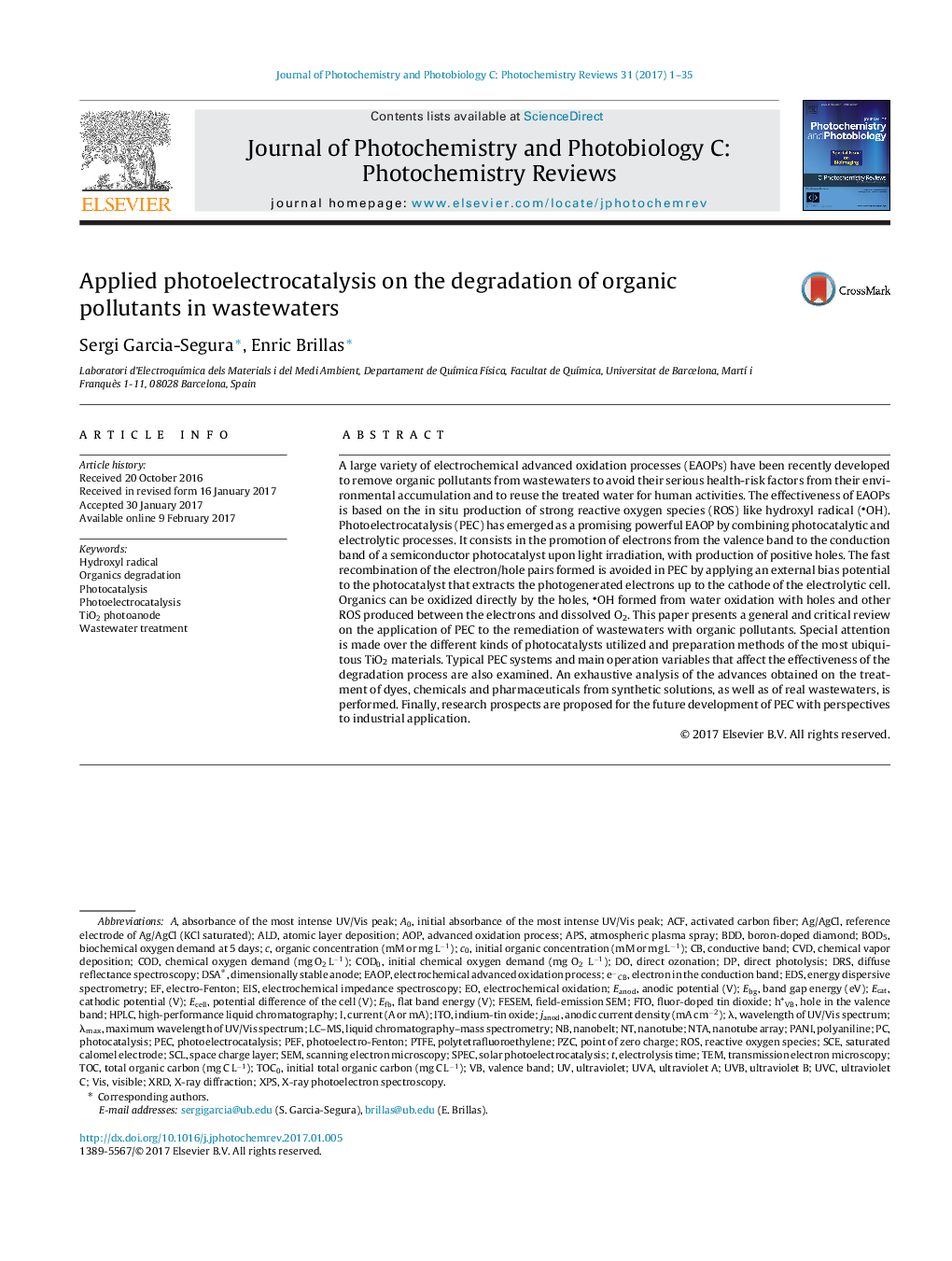| Article ID | Journal | Published Year | Pages | File Type |
|---|---|---|---|---|
| 4754747 | Journal of Photochemistry and Photobiology C: Photochemistry Reviews | 2017 | 35 Pages |
Abstract
A large variety of electrochemical advanced oxidation processes (EAOPs) have been recently developed to remove organic pollutants from wastewaters to avoid their serious health-risk factors from their environmental accumulation and to reuse the treated water for human activities. The effectiveness of EAOPs is based on the in situ production of strong reactive oxygen species (ROS) like hydroxyl radical (OH). Photoelectrocatalysis (PEC) has emerged as a promising powerful EAOP by combining photocatalytic and electrolytic processes. It consists in the promotion of electrons from the valence band to the conduction band of a semiconductor photocatalyst upon light irradiation, with production of positive holes. The fast recombination of the electron/hole pairs formed is avoided in PEC by applying an external bias potential to the photocatalyst that extracts the photogenerated electrons up to the cathode of the electrolytic cell. Organics can be oxidized directly by the holes,
- OH formed from water oxidation with holes and other ROS produced between the electrons and dissolved O2. This paper presents a general and critical review on the application of PEC to the remediation of wastewaters with organic pollutants. Special attention is made over the different kinds of photocatalysts utilized and preparation methods of the most ubiquitous TiO2 materials. Typical PEC systems and main operation variables that affect the effectiveness of the degradation process are also examined. An exhaustive analysis of the advances obtained on the treatment of dyes, chemicals and pharmaceuticals from synthetic solutions, as well as of real wastewaters, is performed. Finally, research prospects are proposed for the future development of PEC with perspectives to industrial application.
- OH formed from water oxidation with holes and other ROS produced between the electrons and dissolved O2. This paper presents a general and critical review on the application of PEC to the remediation of wastewaters with organic pollutants. Special attention is made over the different kinds of photocatalysts utilized and preparation methods of the most ubiquitous TiO2 materials. Typical PEC systems and main operation variables that affect the effectiveness of the degradation process are also examined. An exhaustive analysis of the advances obtained on the treatment of dyes, chemicals and pharmaceuticals from synthetic solutions, as well as of real wastewaters, is performed. Finally, research prospects are proposed for the future development of PEC with perspectives to industrial application.
Keywords
UVBAOPEBGEFBPECTOCFESEMBDDNTAUVCDRSACFBOD5UVAEDSPTFEPZCPEFEAOPSCEDSA®SCLECATλmaxSPECTiO2 photoanodeAg/AgClAPsLC–MSPANIROSVIsALDNanotube arrayDimensionally stable anodeAtmospheric plasma sprayUltravioletUltraviolet Aultraviolet BBoron-Doped DiamondSaturated Calomel ElectrodeElectro-FentonActivated carbon fiberIndium-tin oxideElectrochemical oxidationITOTemEISOrganics degradationWastewater treatmentFTOHydroxyl radicalChemical vapor depositionCVDAtomic layer depositionElectrochemical impedance spectroscopyDiffuse reflectance spectroscopyliquid chromatography–mass spectrometryX-ray photoelectron spectroscopyenergy dispersive spectrometryXPSPhotoelectrocatalysisPhotoelectro-Fentondirect photolysisAdvanced oxidation processElectrochemical advanced oxidation processPhotocatalysisVisibleSpace charge layerultraviolet CSEMScanning electron microscopyTransmission electron microscopyNanobeltNanotubepoint of zero chargeXRDX-ray diffractionPolyanilinepolytetrafluoroethyleneCodhigh-performance liquid chromatographyHPLCvalence bandReactive oxygen species
Related Topics
Physical Sciences and Engineering
Chemical Engineering
Bioengineering
Authors
Sergi Garcia-Segura, Enric Brillas,
